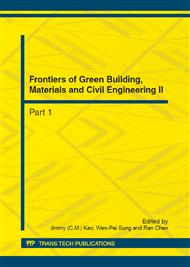p.740
p.748
p.753
p.757
p.762
p.770
p.776
p.780
p.785
Study on the Polyurethane Concrete for the Rapid Repairment of Highway Pavement
Abstract:
Abstract:Polyurethane concrete which applies to the rapid repair highway pavement was systematically researched. Influences on mechanical properties of the polyurethane concrete of cement-dinas and binder-aggregate ratio, curing agent dosage, thinning agent dosage, etc. were analyzed in this paper. Furthermore, the optimal formulation materials were gotten to use in the repairment of used-broken cement blocks in the experiment. Simultaneously, the microstructure of polyurethane concrete and their adhesive situation bewteen waste cement blocks were observed through scanning electron microscope (SEM). The results show that the flexural strength of the specimen for two hours can reach to 6.67 MPa, and the compressive strength can reach to 9.15MPa, which can achieve the rapid pavement repair on highway in two hours, and it is superior to the related Chinese Standard. Besides the SEM images indicate that polyurethane molecular and aggregate are firmly bonded to each other as well as the cementation between polyurethane concrete and concretes, it means that the material has characteristic of rapid repair as well as good mechanical property.
Info:
Periodical:
Pages:
762-769
Citation:
Online since:
August 2012
Authors:
Price:
Сopyright:
© 2012 Trans Tech Publications Ltd. All Rights Reserved
Share:
Citation:


